Analysis on the Agricultural Green Production Efficiency and Driving Factors of Urban Agglomerations in the Middle Reaches of the Yangtze River
Abstract
1. Introduction
2. Methodology
2.1. Agricultural Green Production Efficiency Measurement Model
2.2. Analysis Model of External Driving Factors of Agricultural Green Production Efficiency
2.3. Index Selection and Data Sources
2.3.1. Explanation of Agricultural Green Production Efficiency Evaluation System
2.3.2. Explanation of External Driving Factors of Agricultural Green Production Efficiency
- (1)
- Economic development factors. The level of economic development will affect the industrial structure, technological innovation and application as well as the intensity of environmental protection of a region, and further affect the agricultural green production efficiency of the region [36].
- (2)
- Urbanization development. In the process of urbanization, agricultural land is often transferred to urban construction land, agricultural resources such as farmland are gradually reduced during this process. In the same time, people tend to use agricultural science and technology for agricultural production, which will pose impact on the regional agricultural green production efficiency [37].
- (3)
- Opening up. The amount of foreign capital actually utilized by each city is used to measure the level of city’s opening up. With the deepening of reform and opening up, the utilization of foreign capital in China has shown an upward trend year by year. Agriculture, as one of the earliest industries in China to utilize foreign capital, is a key area of foreign investment. The involvement of foreign capital will affect the input elements of agricultural production technology and management, which is also an important factor affecting the green production efficiency of regional agriculture [38]. On the other hand, opening to the outside world has accelerated the domestic and foreign trade exchanges, and frequent trade is also one of the reasons to promote the development of green production in agriculture.
- (4)
- Industrial structure. In this paper, the proportion of the secondary industry and the proportion of the tertiary industry represents the regional industrial structure factors. A great many of the existing studies believe that industrial structure is an important factor affecting resource utilization. Studies have shown that the industrial structure has a negative impact on the efficiency of resource utilization, and the optimization of industrial structure will improve the allocation of labor and capital [39,40]. Due to the lack of technology and the neglect of the industrial sector on pollution control, it is difficult for the sewage sector to eradicate industrial pollution [41]. The regional industrial development stage and development mode, whether it is the type of high-water-consuming and high-pollution industry, all affect the green production efficiency of regional agriculture. The tertiary industry is closely related to the level of perfection of the regional market mechanism, its activity will have some impact on the green production efficiency of regional agriculture.
- (5)
- Government influence. The government’s expenditure budget for agriculture, forestry and water is used to measure the influence of regional governments. The government’s investment in the construction of agricultural infrastructure, the guidance of industrial transformation, the extension of science and technology, and related environmental policies all play an important role in the green production efficiency of regional agriculture [42,43,44,45].
2.3.3. Data Source Description
3. Empirical Results and Analysis
3.1. Temporal and Spatial Distribution Characteristics of Agricultural Green Production Efficiency
3.1.1. Time Evolution Characteristics of Agricultural Green Production Efficiency
3.1.2. The Spatial Distribution of Agricultural Green Production Efficiency
3.2. Analysis of External Driving Factors of Agricultural Green Production Efficiency
- (1)
- The impact of economic development on agricultural green production efficiency is not significant. Economic development has a certain promoting effect on the improvement of agricultural green production efficiency. As the economic development of the urban agglomeration in the middle reaches of the Yangtze River crossed the Lewis turning point, the endowment of agricultural factors has undergone tremendous changes. The phenomenon of machines replacing humans in agricultural production has become more and more common, which has promoted the improvement of agricultural green production efficiency [54]. Meanwhile, rapid economic development is often accompanied by the occupation of agricultural land and other resources, so that the supply of farmland and other agricultural production factor resources cannot be guaranteed [55].
- (2)
- The development of urbanization hinders the improvement of agricultural green production efficiency. The development of urbanization is mainly manifested in population urbanization and land urbanization. With the gradual advancement of population urbanization, a large number of rural young and middle-aged laborers are gradually moving to urban areas, making the direct labor force in rural areas appear “aging” and other characteristics, agricultural development is greatly affected, resulting in a decline in agricultural production efficiency, due to the loss of young and middle-aged labor force, the popularization of agricultural science and technology has become more difficult [56]. At the same time, in the process of land urbanization, a large amount of agricultural land and ecological land are gradually transformed into urban construction land, which hinders the improvement of the agricultural green production efficiency of the urban agglomeration in the middle reaches of the Yangtze River. This is similar to the research results of He [57], that the development of land urbanization is not conducive to the improvement of technical efficiency of grain production, economic urbanization will change the consumption pattern, thus, affecting the agricultural planting structure, and the discharge of industrial wastewater is not conducive to the improvement of technical efficiency of grain production.
- (3)
- Opening to the outside world promotes the improvement of agricultural green production efficiency. China’s integration into the global economy will lead to continued improvements in the green production efficiency of Chinese agriculture. Foreign capital entering the agricultural sector could provide a large amount of funds for production development. Because foreign capital is usually a collection of production factors such as management experience, marketing channels, and advanced technology, the technology spillover effect it brings will often provide more efficient production for agricultural development. It is beneficial for improving the original production organization and promoting the improvement of regional agricultural green production efficiency [58]. At the same time, the overall level of economic development and cultural education in the urban agglomeration in the middle reaches of the Yangtze River is relatively high. It would provide a think tank guarantee for the digestion and utilization of foreign capital technology spillovers, which also boosts the agricultural green production efficiency of the urban agglomeration.
- (4)
- The impact of industrial structure changes on agricultural green production efficiency is not significant. The industry in city clusters in the middle reaches of the Yangtze River accounts for the highest proportion among the three industries. The increase of investment in industrial development drives the demand for agricultural raw materials, and the feedback effect of industry is good. Industrial development indirectly drives the prosperity of agriculture. However, since China’s industry began to nurture agriculture at the beginning of the 21st century, compared with the first industrialized countries, China is also accompanied by the lag phenomenon of employment structure transformation and urbanization, the input of various industrial factors has no significant elastic effect on the growth of agricultural efficiency [59,60]. Similarly, due to problems in system and mechanism, regional differences, technology application, and other aspects, the coupling development between agriculture and service industry is faced with great difficulties. Therefore, the impact of the difference in industrial structure on the green production efficiency of regional agriculture is more uncertain and does not have significant impact [61].
- (5)
- Government intervention hinders the improvement of agricultural green production efficiency. China′s agricultural production is affected by factors such as complex natural conditions and the “small and weak” business entities, the resulting production are often more uncertain than other industries. In order to promote the development of agricultural production, the government often implements greater intervention and subsidies [62]. However, with the continuous development of the market economy, the improvement of agricultural production efficiency in the urban agglomerations in the middle reaches of the Yangtze River is more and more closed to price leverage. Excessive government subsidies will make agricultural development a strong dependence, inhibit the increase in production enthusiasm and even appear the vicious circle of rising production cost “floor” and upside down domestic and foreign agricultural product prices, which is not conducive to urban agglomerations to improve agricultural green production efficiency. This is generally consistent with the research conclusions of Liu and Li [63,64], that government intervention presents a changing trend of first promoting and then hindering the growth of agricultural green production efficiency, the marketization process of city clusters in the middle reaches of the Yangtze River is rapid, the coupling degree between government intervention and marketization process is low, which hinders the improvement of agricultural green production efficiency.
4. Conclusions
- (1)
- Agricultural green production efficiency is low and is mainly affected by the level of technical efficiency. The agricultural green production efficiency of the urban agglomeration in the middle reaches of the Yangtze River is relatively low. Taking 2009 and 2013 as the turning points, the agricultural green production efficiency has shown an upward-decreasing-stable phase trend. At the same time, the input scale of agricultural land and other factors of production is relatively reasonable, and the scale efficiency of agricultural green production is relatively good. The decline of agricultural green production efficiency mainly comes from the fluctuation of pure technical efficiency, and there is low efficiency in the utilization of factor resources. Pure technical efficiency is the key factor affecting the green production efficiency of agriculture.
- (2)
- Regional differences in agricultural green production efficiency is obvious and the gap is gradually increasing. The spatial distribution of agricultural green production efficiency in the urban agglomeration in the middle reaches of the Yangtze River presents the characteristics of “high in the west and low in the east”, with obvious differences in efficiency among regions and gradually increasing gaps. Due to the developed economy and improved crop trading market mechanism, Wuhan city circle underwent agricultural modernization transformation earlier, and the green agricultural production efficiency was higher than that of Changsha-Zhutan city group and the Poyang Lake city group, which had relatively low economic development level. At the same time, as time goes by, the high-efficiency areas of agricultural production gradually converge to the Wuhan city circle and have the “continuation effect” of high-efficiency agricultural production. The area and distribution of high-efficiency areas gradually decrease and develop from equilibrium to polarization.
- (3)
- The role of external drivers of agricultural green production efficiency is heterogeneous. The estimation results of the panel fixed effects Tobit model show that the driving effects of external factors influencing the agricultural green production efficiency of the urban agglomeration in the middle reaches of the Yangtze River are significantly different. The development of urbanization hinders the improvement of green production efficiency of agriculture. Among them, the gradual development of population urbanization makes a large number of rural young and middle-aged labor force gradually transferred to urban areas, leading to the decline of agricultural production efficiency. In the process of land urbanization, a large amount of agricultural and ecological land is gradually transformed into urban construction land, which hinders the improvement of agricultural green production efficiency in urban agglomeration in the middle reaches of the Yangtze River. At the same time, due to that excessive government subsidies can make agricultural development form strong dependence, inhibit the production enthusiasm, appear even agricultural production costs “floor” vicious cycle up and down prices for agricultural products at home and abroad, so the government intervention to promote the efficiency of urban agglomeration in the middle reach of Yangtze river green agricultural production also has significant inhibitory effect. On the other hand, the entry of foreign capital into the agricultural field provides a large amount of capital, management experience, marketing channels and advanced technologies for production development, and the technology spillover effect it brings is often conducive to improving the original production organization form and promoting the improvement of regional agricultural green production efficiency. Economic development plays a certain role in promoting the improvement of agricultural green production efficiency, but at the same time, rapid economic development is often accompanied by the occupation of agricultural land and other resources, and the supply of agricultural production factors such as farmland cannot be guaranteed. Therefore, economic development has no significant impact on agricultural green production efficiency. Similarly, due to problems in system and mechanism, regional differences, technology application and other aspects, the coupling development of agriculture and service industry is faced with great difficulties, and the impact of industrial structure differences on regional agricultural green production efficiency is highly uncertain and does not have significant impact.
Author Contributions
Funding
Conflicts of Interest
References
- Wang, J.; Luo, C. The outline of China’s regional coordinated development strategy in new era. Reform 2017, 12, 52–67. [Google Scholar]
- Wu, W.; Tang, H.; Yang, P.; You, L.; Zhou, Q.; Chen, Z.; Shibasaki, R. Scenario-based assessment of future food security. J. Geogr. Sci. 2011, 21, 3–17. [Google Scholar] [CrossRef]
- Wu, Q.; Ma, H.; Wu, L.; Lu, J. Spatial-temporal pattern evolution of agricultural economy of urban agglomeration in the middle reaches of the Yangtze River. Guangdong Agric. Sci. 2016, 43, 152–158,193. [Google Scholar] [CrossRef]
- Yin, P.; Fang, X.; Yun, Y. Regional differences of vulnerability of food security in China. J. Geogr. Sci. 2009, 19, 532. [Google Scholar] [CrossRef]
- Sun, W.; Wang, R.; Qian, J.; Shengnan, H. Study on connotation and evaluation of the agricultural green development. Chin. J. Agric. Resour. Reg. Plan. 2019, 40, 14–21. [Google Scholar] [CrossRef]
- Gong, Q.; Li, X. Construction and measurement of agricultural green development index: 2005–2018. Reform 2020, 311, 133–145. [Google Scholar]
- Sun, W.; Li, Y.; Wang, D.; Fan, J. The efficiencies and their changes of China’s resources-based cities employing DEA and Malmquist index models. J. Geogr. Sci. 2012, 22, 509–520. [Google Scholar] [CrossRef]
- Charnes, A.; Cooper, W.W.; Rhodes, E. Measuring the efficiency of decision making units. Eur. J. Oper. Res. 1978, 2, 429–444. [Google Scholar] [CrossRef]
- Restuccia, D.; Yang, D.T.; Zhu, X. Agriculture and aggregate productivity: A quantitative cross-country analysis. J. Monet. Econ. 2008, 55, 234–250. [Google Scholar] [CrossRef]
- Vollrath, D. Land distribution and international agricultural productivity. Am. J. Agric. Econ. 2007, 89, 202–216. [Google Scholar] [CrossRef]
- Ruttan, V.W. Productivity growth in world agriculture: Sources and constraints. J. Econ. Perspect. 2002, 16, 161–184. [Google Scholar] [CrossRef]
- Li, X. A study of the driving factors of agricultural production efficiency in China. J. Chongqing Univ. 2015, 21, 37–46. [Google Scholar] [CrossRef]
- Xing, H.; Zhang, X.; Deng, Y. Empirical analysis on the relationship between agricultural production efficiency and its influencing factors—based on the data of Hubei province. Chin. J. Agric. Resour. Reg. Plan. 2016, 37, 198–203. [Google Scholar] [CrossRef]
- Zhang, S.; Jiang, W. Energy efficiency measures: Evolution, Controversy, and the Future. J. Quant. Tech. Econ. 2016, 33, 3–24. [Google Scholar]
- Li, Q.; Li, G.; Yin, C.; Liu, F. Spatial characteristics of agricultural green total factor productivity at county level in Hebei province. J. Ecol. Rural Environ. 2019, 35, 845–852. [Google Scholar] [CrossRef]
- Guo, S.; Zhang, M.; Wu, G. Study on agricultural production efficiency and its influencing factors in Heilongjiang reclamation area. J. Northeast Agric. Univ. 2019, 50, 68–75. [Google Scholar]
- Wu, Q.; Wu, C. Research on evaluation model of energy efficiency based on DEA. J. Manag. Sci. 2009, 22, 103–112. [Google Scholar] [CrossRef]
- Tone, K. A slacks-based measure of efficiency in data envelopment analysis. Eur. J. Oper. Res. 2001, 130, 498–509. [Google Scholar] [CrossRef]
- Deng, G.; Li, L.; Song, Y. Provincial water use efficiency measurement and factor analysis in China: Based on SBM-DEA model. Ecol. Indic. 2016, 69, 12–18. [Google Scholar] [CrossRef]
- Cheng, X.; Li, N.; Mu, H.; Guo, Y.; Jiang, Y. Study on total-factor energy efficiency in three provinces of northeast China based on SBM model. Energy Procedia 2018, 152, 131–136. [Google Scholar] [CrossRef]
- Shang, Y.; Liu, H.; Lv, Y. Total factor energy efficiency in regions of China: An empirical analysis on SBM-DEA model with undesired generation. J. King Saud Univ. Sci. 2020, 32, 1925–1931. [Google Scholar] [CrossRef]
- Liu, Y.; Zou, L.; Wang, Y. Spatial-temporal characteristics and influencing factors of agricultural eco-efficiency in China in recent 40 years. Land Use Policy 2020, 97, 104794. [Google Scholar] [CrossRef]
- Çelen, A. Efficiency and productivity (TFP) of the Turkish electricity distribution companies: An application of two-stage (DEA&Tobit) analysis. Energy Policy 2013, 63, 300–310. [Google Scholar] [CrossRef]
- Ding, X.; Fu, Z.; Jia, H. Study on Urbanization Level, Urban Primacy and Industrial Water Utilization Efficiency in the Yangtze River Economic Belt. Sustainability 2019. [Google Scholar] [CrossRef]
- Wu, J.; Yin, P.; Sun, J.; Chu, J.; Liang, L. Evaluating the environmental efficiency of a two-stage system with undesired outputs by a DEA approach: An interest preference perspective. Eur. J. Oper. Res. 2016, 254, 1047–1062. [Google Scholar] [CrossRef]
- Ding, X.; He, J.; Wang, L. Inter-provincial water resource utilization efficiency and Its Driving Factors considering undesirable outputs—Based on SE-SBM and Tobit models. Chin. J. Popul. Resour. Environ. 2017, 28, 157–164. [Google Scholar]
- Guo, Y.; Sayed, T.; Essa, M. Real-time conflict-based Bayesian Tobit models for safety evaluation of signalized intersections. Accid. Anal. Prev. 2020, 144, 105660. [Google Scholar] [CrossRef]
- Dalei, N.N.; Joshi, J.M. Estimating technical efficiency of petroleum refineries using DEA and tobit model: An India perspective. Comput. Chem. Eng. 2020, 142, 107047. [Google Scholar] [CrossRef]
- Selim, S.; Bursalioglu, S.A. Analysis of the determinants of universities efficiency in Turkey: Application of the data envelopment analysis and panel tobit model. Procedia Soc. Behav. Sci. 2013, 89, 895–900. [Google Scholar] [CrossRef]
- Wu, M.; Zhao, M. Measurement of agricultural efficiency in China and its influencing factors—Perspective of discrepancy. J. Econ. Water Resour. 2017, 35, 63–68. [Google Scholar] [CrossRef]
- Yang, Q.; Wang, J.; Li, C.; Liu, X. The spatial differentiation of agricultural green total factor productivity and its driving factor recognition in China. J. Quant. Tech. Econ. 2019, 21–37. [Google Scholar]
- Escobar, N.; Tizado, E.J.; zu Ermgassen, E.K.H.J.; Löfgren, P.; Börner, J.; Godar, J. Spatially-explicit footprints of agricultural commodities: Mapping carbon emissions embodied in Brazil’s soy exports. Glob. Environ. Chang. 2020, 62, 102067. [Google Scholar] [CrossRef]
- Shen, L.; Sun, Y. Review on carbon emissions, energy consumption and low-carbon economy in China from a perspective of global climate change. J. Geogr. Sci. 2016, 26, 855–870. [Google Scholar] [CrossRef]
- Duan, H.; Zhang, Y.; Zhao, J. Carbon Footprint analysis of Farmland Ecosystems in China. J. Soil Water Conserv. 2017, 25, 203–208. [Google Scholar]
- Wang, Y.; Gu, S. Analysis on Carbon Footprint and Ecological Pressure of China’s electric Power industry from 2006 to 2015. Acta Sci. Circumstantiae 2018, 38, 4873–4878. [Google Scholar]
- Fei, R.; Lin, B. The integrated efficiency of inputs–outputs and energy—CO2 emissions performance of China’s agricultural sector. Renew. Sustain. Energy Rev. 2017, 75, 668–676. [Google Scholar] [CrossRef]
- Gras, C.; Cáceres, D.M. Technology, nature’s appropriation and capital accumulation in modern agriculture. Curr. Opin. Environ. Sustain. 2020, 45, 1–9. [Google Scholar] [CrossRef]
- Ma, S.; Feng, H. Will the decline of efficiency in China’s agriculture come to an end? An analysis based on opening and convergence. China Econ. Rev. 2013, 27, 179–190. [Google Scholar] [CrossRef]
- Xu, L.; Tan, J. Financial development, industrial structure and natural resource utilization efficiency in China. Resour. Policy 2020, 66, 101642. [Google Scholar] [CrossRef]
- Qin, B.; Liu, J.; Ge, L. Environmental regulation intensity, industrial structure upgrade and improvement of China’s resource allocation. J. Chongqing Technol. Bus. Univ. Soc. Sci. Ed. 2020, 9, 1–10. [Google Scholar]
- Hu, J. Negative effects of industry pollution on agriculture in China. Ecol. Econ. 1998, 5, 3–5. [Google Scholar]
- Adom, P.K.; Adams, S. Decomposition of technical efficiency in agricultural production in Africa into transient and persistent technical efficiency under heterogeneous technologies. World Dev. 2020, 129, 104907. [Google Scholar] [CrossRef]
- Yang, J.; Lin, Y. Driving factors of total-factor substitution efficiency of chemical fertilizer input and related environmental regulation policy: A case study of Zhejiang Province. Environ. Pollut. 2020, 263, 114541. [Google Scholar] [CrossRef] [PubMed]
- Xia, M.; Zhang, Y.; Zhang, Z.; Liu, J.; Ou, W.; Zou, W. Modeling agricultural land use change in a rapid urbanizing town: Linking the decisions of government, peasant households and enterprises. Land Use Policy 2020, 90, 104266. [Google Scholar] [CrossRef]
- Gao, P.; Wang, X. Fiscal input, environmental regulation and efficiency of green technological innovation: Based on the data of large industrial enterprises from 2008 to 2015. Ecol. Econ. 2018, 34, 93–99. [Google Scholar]
- Huang, S.-L.; Yeh, C.-T.; Chang, L.-F. The transition to an urbanizing world and the demand for natural resources. Curr. Opin. Environ. Sustain. 2010, 2, 136–143. [Google Scholar] [CrossRef]
- Sun, M.; Zhang, M. The impact of bird flu on agriculture and related industries. World Surv. Res. 2004, 4, 5–6. [Google Scholar]
- Liu, X. The development of modern agriculture in Wuhan urban circle under the background of “Two-oriented Society” construction. Bus. China 2010, 191, 193. [Google Scholar]
- Xie, Z.; Ren, S.; Li, Y.; Jingyu, L. Study on efficiency of agricultural production in Jiangxi province based on DEA model. Acta Agric. Jiangxi 2015, 27, 142–145. [Google Scholar] [CrossRef]
- Zhu, L.; He, R.; Zheng, W. Spatial and temporal pattern and driving factors of urban innovation efficiency in city clusters in the middle Reaches of Yangtze River. Resour. Environ. Yangtze Basin 2019, 28, 2279–2288. [Google Scholar]
- Tamilselvi, R.; Ramesh, M.; Lekshmi, G.S.; Bazaka, O.; Levchenko, I.; Bazaka, K.; Mandhakini, M. Graphene oxide—Based supercapacitors from agricultural wastes: A step to mass production of highly efficient electrodes for electrical transportation systems. Renew. Energy 2020, 151, 731–739. [Google Scholar] [CrossRef]
- Zhang, J.; Zhang, A. Study on relationship between spatial heterogeneity of land resources and economic development: A case study of Wuhan urban agglomeration. J. Nat. Resour. 2015, 30, 725–735. [Google Scholar] [CrossRef]
- Kuersteiner, G.M. Invariance principles for dependent processes indexed by Besov classes with an application to a Hausman test for linearity. J. Econom. 2019, 211, 243–261. [Google Scholar] [CrossRef]
- Panagopoulos, Y.; Dimitriou, E. A large-scale nature-based solution in agriculture for sustainable water management: The Lake Karla case. Sustainability 2020, 12, 6761. [Google Scholar] [CrossRef]
- Guo, B.; He, D.; Zhao, X.; Zhang, Z.; Dong, Y. Analysis on the spatiotemporal patterns and driving mechanisms of China’s agricultural production efficiency from 2000 to 2015. Phys. Chem. Earthparts A/B/C 2020, 102909. [Google Scholar] [CrossRef]
- Ariken, M.; Zhang, F.; Liu, K.; Fang, C.; Kung, H.-T. Coupling coordination analysis of urbanization and eco-environment in Yanqi Basin based on multi-source remote sensing data. Ecol. Indic. 2020, 114, 106331. [Google Scholar] [CrossRef]
- He, Y.; Qi, Y. Study on the influence of urbanization development on the technical efficiency of grain production—Based on the panel data of 13 major grain-producing areas in China. Chin. J. Agric. Resour. Reg. Plan. 2019, 40, 101–110. [Google Scholar] [CrossRef]
- Wu, H.; Ren, S.; Yan, G.; Hao, Y. Does China’s outward direct investment improve green total factor productivity in the “Belt and Road” countries? Evidence from dynamic threshold panel model analysis. J. Environ. Manag. 2020, 275, 111295. [Google Scholar] [CrossRef]
- Liu, M.; Lu, F. Agricultural and industrial sector: Feeding each other or back-feeding—A study based on spatial durbin model. Rev. Econ. Manag. 2017, 33, 153–160,167. [Google Scholar] [CrossRef]
- Chen, S. The stages of industry and industry nurturing agriculture. J. Chongqing Technol. Bus. Univ. (West Forum) 2015, 25, 1–10. [Google Scholar] [CrossRef]
- Luo, M. The dilemma and realization path of the coupling development of modern agriculture and modern service industry. Agric. Econ. 2020, 8, 15–17. [Google Scholar]
- Zheng, Y. Reasons for the strong dependence on the government for agricultural transformation and upgrading and the countermeasures—On the optimization and transformation of the realization form of agricultural organization. Issues Agric. Econ. 2016, 10, 4–8. [Google Scholar]
- Liu, Z. Government intervention, marketization process and agricultural production efficiency. North. Hortic. 2019, 148–157. [Google Scholar] [CrossRef]
- Li, H.; Ma, C. The impact of government support, marketization on innovation efficiency of agricultural techniques: A case study of six provinces in the middle of China. J. China Agric. Univ. 2017, 22, 189–198. [Google Scholar] [CrossRef]
- Ding, X.H.; Tang, N.; He, J.H. The threshold effect of environmental regulation, FDI agglomeration and water utilization efficiency under “Double Control Actions”—An empirical test based on Yangtze River Economic Belt. Water 2019, 11, 452. [Google Scholar] [CrossRef]
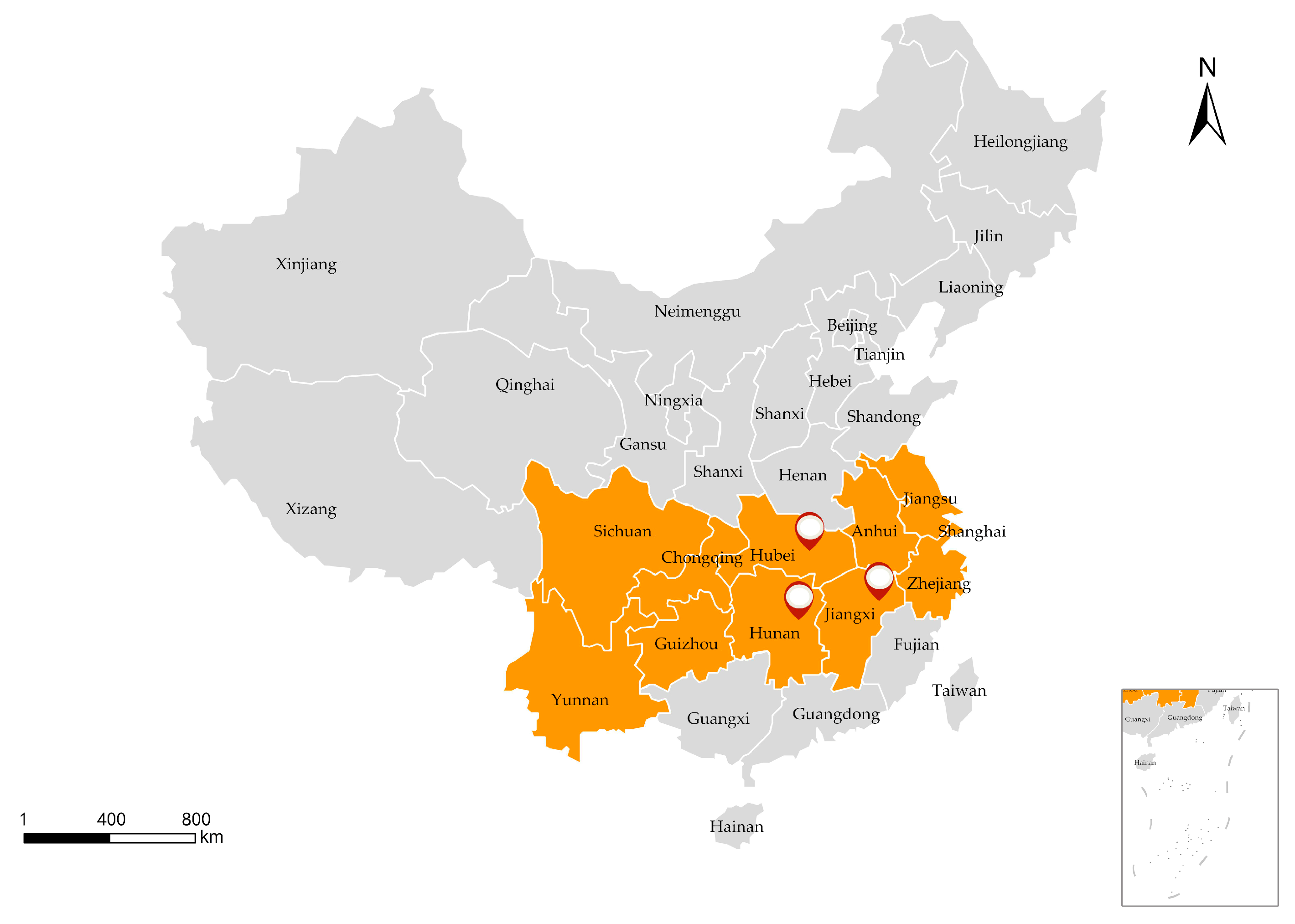
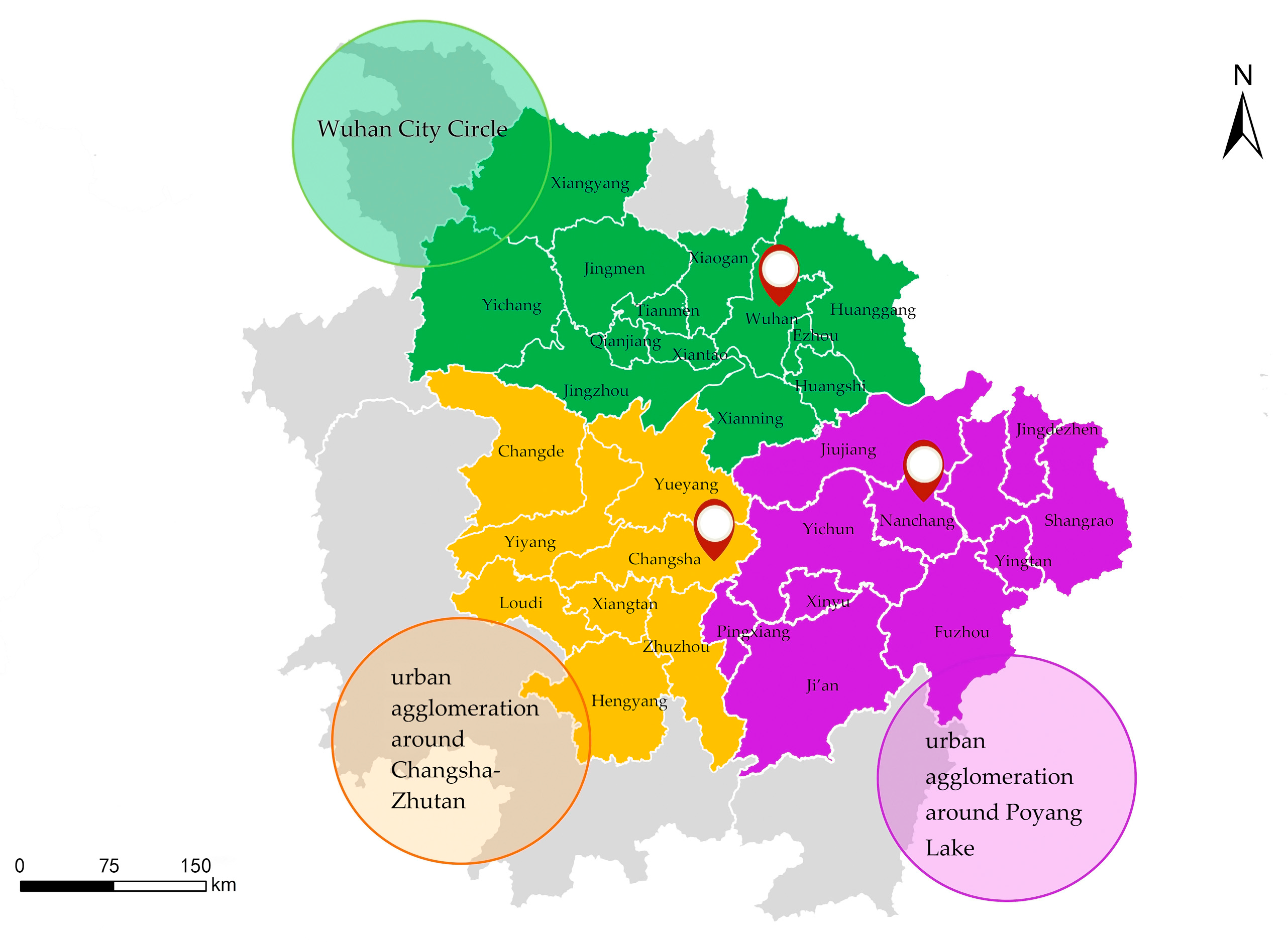
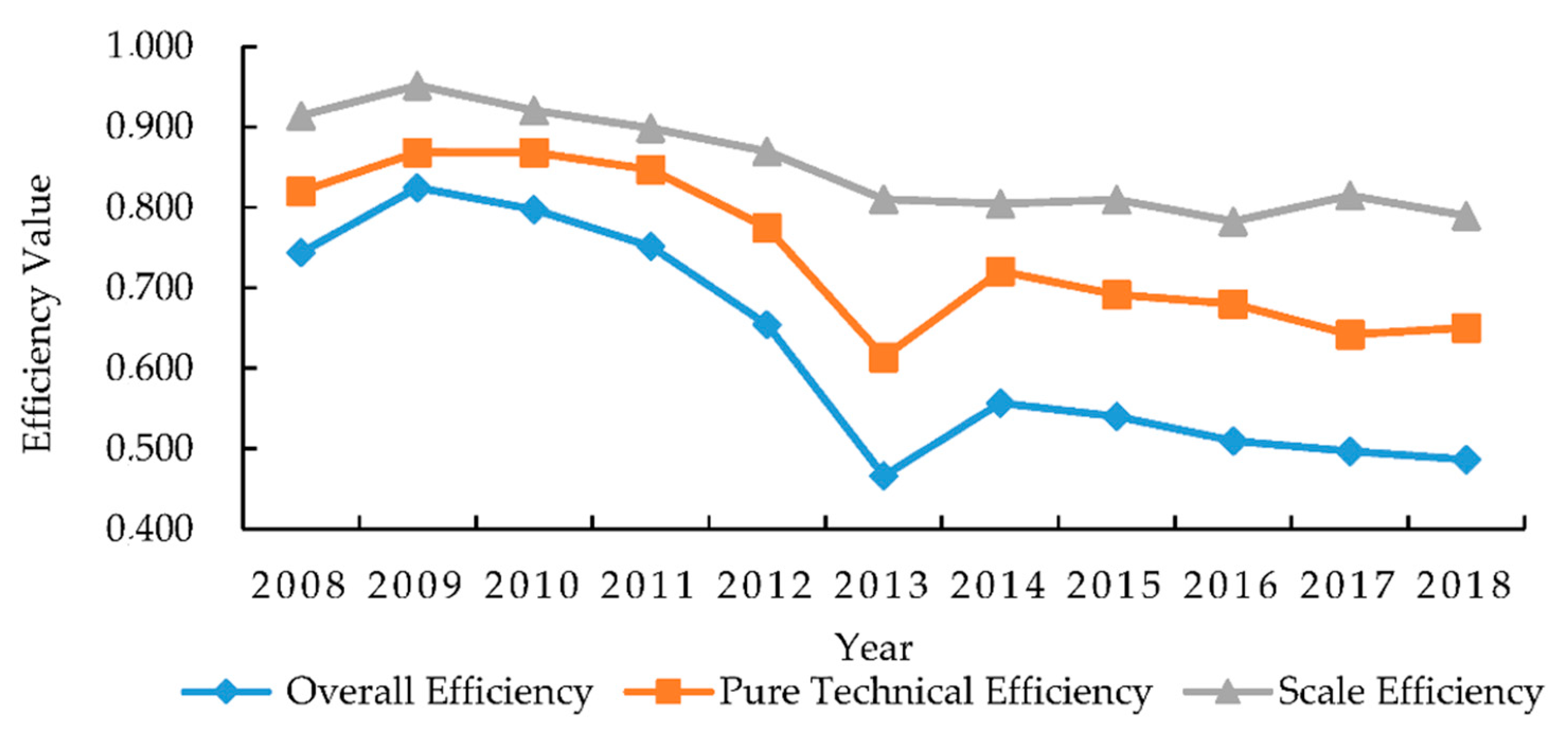
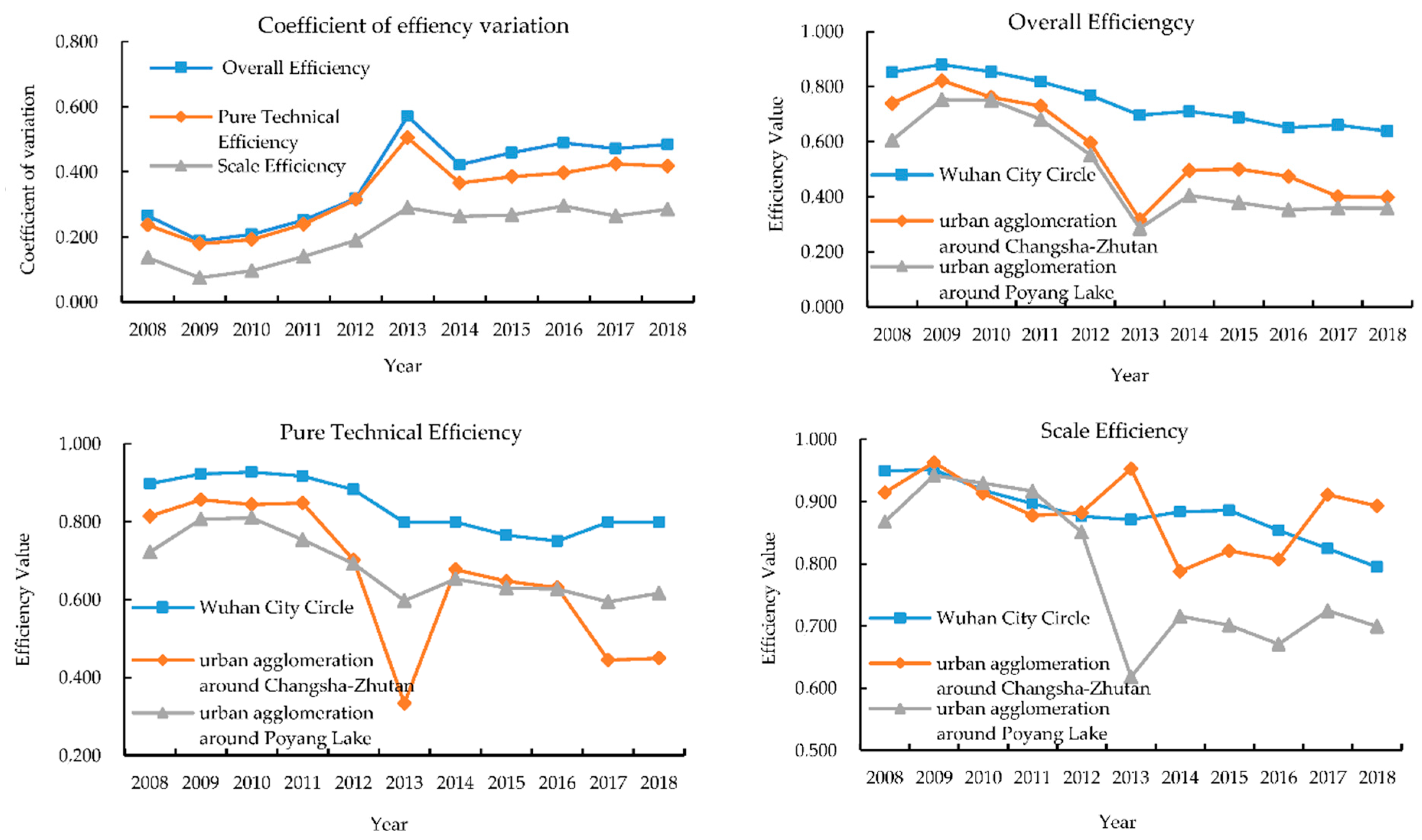

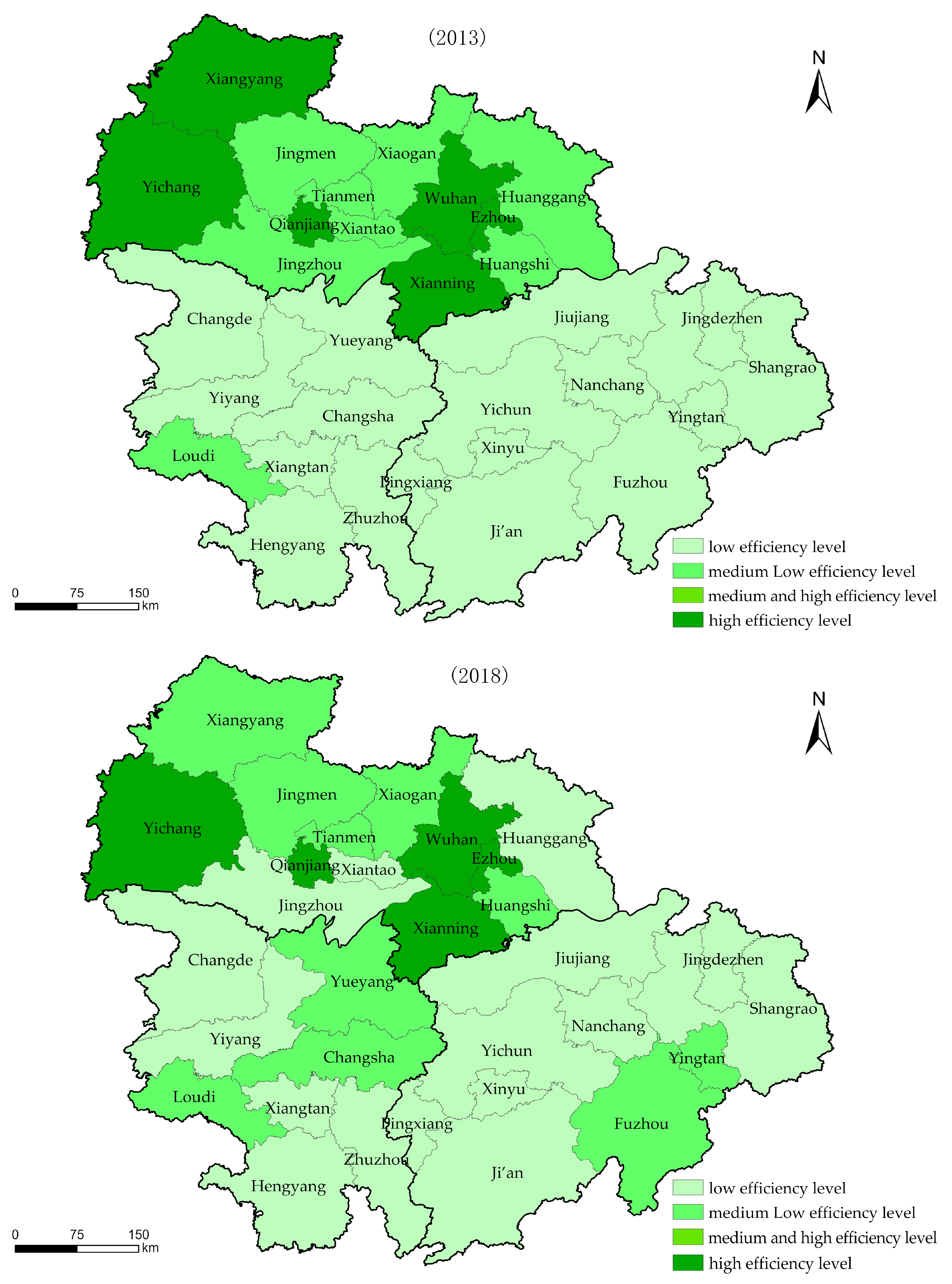
| Carbon Source | Emission Factor | References |
|---|---|---|
| Agricultural farming and irrigation | 579.0800 kg/hm2 | ORNL (Oak Ridge National Laboratory) |
| Fertilizer usage | 0.8956 kg/kg | Duan [34] |
| Agricultural electrification | Mean electricity carbon emission factor kg/kWh | Wang [35] |
| Variable | Regression Coefficients | Standard Deviation | t Statistics | p Value |
|---|---|---|---|---|
| GDP per capita | 0.120 | 0.257 | 0.78 | 0.437 |
| Urbanization rate | −1.146 *** | 0.306 | −3.75 | 0.000 |
| Actual utilization of foreign capital | 0.010 *** | 0.003 | 3.26 | 0.001 |
| Proportion of secondary industry | 0.180 | 0.540 | 0.33 | 0.739 |
| Proportion of tertiary industry | −0.669 | 0.848 | −0.79 | 0.430 |
| Expenditure on agriculture, forestry and water supplies | −0.005 *** | 0.001 | −4.76 | 0.000 |
Publisher’s Note: MDPI stays neutral with regard to jurisdictional claims in published maps and institutional affiliations. |
© 2020 by the authors. Licensee MDPI, Basel, Switzerland. This article is an open access article distributed under the terms and conditions of the Creative Commons Attribution (CC BY) license (http://creativecommons.org/licenses/by/4.0/).
Share and Cite
Wang, L.; Qi, Z.; Pang, Q.; Xiang, Y.; Sun, Y. Analysis on the Agricultural Green Production Efficiency and Driving Factors of Urban Agglomerations in the Middle Reaches of the Yangtze River. Sustainability 2021, 13, 97. https://doi.org/10.3390/su13010097
Wang L, Qi Z, Pang Q, Xiang Y, Sun Y. Analysis on the Agricultural Green Production Efficiency and Driving Factors of Urban Agglomerations in the Middle Reaches of the Yangtze River. Sustainability. 2021; 13(1):97. https://doi.org/10.3390/su13010097
Chicago/Turabian StyleWang, Lei, Zengrui Qi, Qinghua Pang, Yibo Xiang, and Yanli Sun. 2021. "Analysis on the Agricultural Green Production Efficiency and Driving Factors of Urban Agglomerations in the Middle Reaches of the Yangtze River" Sustainability 13, no. 1: 97. https://doi.org/10.3390/su13010097
APA StyleWang, L., Qi, Z., Pang, Q., Xiang, Y., & Sun, Y. (2021). Analysis on the Agricultural Green Production Efficiency and Driving Factors of Urban Agglomerations in the Middle Reaches of the Yangtze River. Sustainability, 13(1), 97. https://doi.org/10.3390/su13010097




